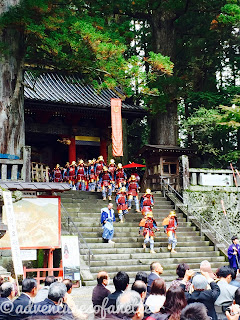 |
| Festival participants waiting for the parade to begin |
The parade began outside the entrance to the Taishōgun, which is Nikko's most famous temple. It is inside this temple area where the famous shogun Tokugawa Ieyasu has his final resting place. This year the event was particular important, as it commemorates the 400 years since the death of the shogun, and as you can imagine the area was packed with people traveling from near and afar to enjoy the historical event.


I traveled to Nikko with my mother and stepfather to visit the famous temples here, and we timed it so that we could see parts of the big festival as well. Although we arrived in Nikko a bit later than planed we were extremely lucky with the timing. Because it had been raining slightly in the morning the festival was delayed with a couple of hours, which gave us just enough time to do some sightseeing at some of the minor temples before the actual festival began. We lined up by the entrance gate to the Taishōgun, and ended up getting a spectacular view of the parade from where we stood. Here are some of my pictures from the parade:


Toshogu Tourist Information
| Name of Place | Toshogu Shrine (東照宮) |
|---|---|
| Address | 〒321-1431 栃木県日光市山内2301 2301 Sannai, Nikko, Tochigi Prefecture 321-1431 |
| Admission | Tosho-gu Shrine tickets - ¥1,300 for adults, ¥450 for elementary and middle-school students |
| Business Hours | Open all year from 8:00 a.m._5:00 p.m. (closes at 4:00 p.m. in November through March) Note: Last entry is 30 minutes before closing time |
| Public Transit Access |
Tobu-nikko Station → Tobu bus (for Chuzenji Onsen or Yumoto Onsen) (5 minutes) → Shinkyo Bridge bus stop → 10 minutes on foot * Or a 40-minute walk from Tobu-nikko Station. |
| Homepage | http://www.toshogu-koyoen.com/toshogu/ (Japanese) http://www.nikko-jp.org/english/toshogu/index.html (Nikko Tourist Association, English) |
Recommended Hotels in Nikko
|
Nikko Station Hotel Classic |
Iwaiyado Jyuan Ryokan |
Kinugawa Onsen Hotel |
Nikkorisou Backpackers |
Related blog posts
- All blog posts from Nikko
- Sightseeing in Nikko: The Grand Autumn Festival Shuki Taisai (秋季大祭)
- Sightseeing in Nikko: A Visit to the World Heritage listed Toshogu Shrine (東照宮)
- Nikko: A visit to the Emperor's Summer House - The Tamozawa Imperial Villa
- Sightseeing in Nikko: The Kanmangafuchi Abyss (憾満ヶ淵) and Bake Jizo
- Nikko Hotels: Nikko Tokinoyuu Hotel (日光 季の遊)
- Nikko Nightlife: Bar de Nikko
- Nikko: A Cross Country Skiing Experience in Oku-Nikko
- [Hotel Reviews] Nikko Astraea Hotel in Oku-Nikko - Nikko National
- All blog posts about seasonal Kanto events
- Spring
- Hiking in Tokyo: Sakura viewing (花見) at Mount Takao
- Tokyo Cherry Blossom Spots: Nakameguro's Meguro-gawa River (目黒川)
- Saitama: Pink Moss Viewing in Chichibu Hitsujiyama Park
- Summer
- Bon Odori Midsummer Festival in Ebisu (恵比寿駅前盆踊り)
- Pikachu Outbreak in Yokohama - Pikachu Tairyou Hassei-Chu
- Summer in Tokyo: Ultra Japan at Tokyo Odaiba!
- Autumn
- Yokohama: Autumn Views at the Sankeien Garden
- Sightseeing in Nikko: The Grand Autumn Festival Shuki Taisai
- Sightseeing in Saitama: The Kawagoe Festival
- Winter
- Chiba: Winter Illumination at the Country Farm Tokyo German Village
- Yokohama: Christmas Market at the Red Brick Warehouse
Thank you for reading! Please feel free to leave any comments or questions below
- Anette




























































